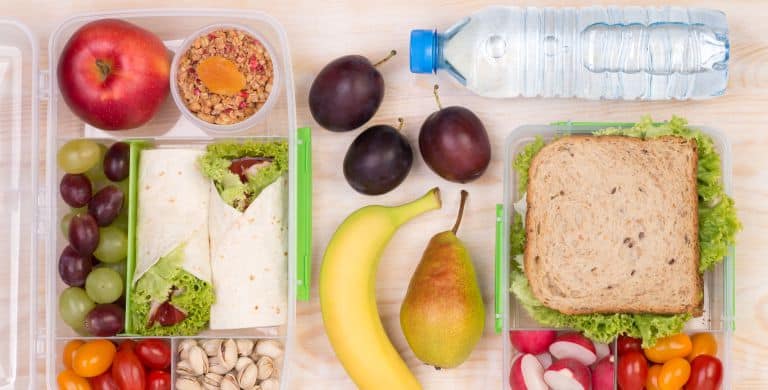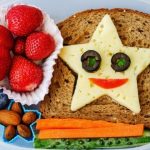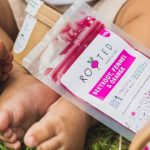Learning doesn’t just make you smart. It also takes energy. That’s why it’s so important to have healthy meals for children, which include nutritious snacks to keep them going.
Knowing what to pack in your child’s lunchbox can be tricky, especially for fussy eaters. However, if you choose fresh and colourful ingredients, chances are that what you make will be more wholesome and appetising.
Tip: Encourage children to help choose and prepare their own lunch. They might like to make a list of the foods they enjoy. Praise your child when they choose healthy foods for their lunchbox.
There are lots of food choices available for lunchboxes. However, it can sometimes be difficult to decide which foods are healthy choices.
Here are 10 healthy lunchbox tips:
Fruit – include at least one serve of fruit in your child’s lunchbox each day. Use fresh seasonal fruit whenever possible. Some ideas for fruit include apple, banana, mandarin, orange, watermelon cubes, mango cheeks, seedless grapes, nectarine, berries, pear. Dried fruit is sticky and high in sugar, so have it occasionally.
Don’t: Best left out of the lunch box are dried fruit bars, which are very high in sugar, low in fibre and stick to children’s teeth causing tooth decay.
Vegetables – try vegetable sticks with dip or a small container with mixed vegetables such as cherry tomatoes, carrot sticks, cucumber, yellow, red or green capsicum, green beans, snow peas & corn on the cob.
Don’t: Chips and packets of crisps are best left for parties and special occasions.
Milk, yoghurt and custard – include a small drink of milk (freeze overnight) wrapped in a cloth in the lunch box. Fruit yoghurts should be kept cool in an insulated lunch box.
Don’t: Best left out of the lunch box are ‘dairy desserts’ and flavoured milks, which are high in sugar.
Dips, cheese and biscuits – pre-packaged or your own homemade versions of cheese and crackers are fine. Children enjoy mini packaged cheeses.
Don’t: Avoid sweet dips such as chocolate spreads. ‘Oven-baked’ savoury biscuits are just as high in salt and fat as chips and are best avoided.
Different breads add interest – include a variety of bread, especially if children begin to lose interest in sandwiches. Try bread rolls, pita bread, flat bread, bagels, fruit loaf or buns, focaccias, scones, muffins, crumpets, crispbreads, rice cakes or corn thins. Other grain-based meals can also be excellent choices for school lunches, such as rice or pasta, crackers and crispbreads.
Don’t: White bread is made from wheat that has had the germ and bran removed, thereby reducing the fibre, B group vitamins, vitamin E and minerals such as iron, zinc, magnesium and phosphorus. (choose wholemeal or wholegrain where available).
Try to avoid muesli bars and chocolate bars in lunch boxes as they are very high in sugar.
Vary the fillings – fillings can include vegemite or other yeast extract, peanut butter, cheese (try different types), sliced cold meats, chopped roast meat with pickles or chutney.
Don’t: Avoid chocolate spreads, jams and honey, and fatty meats like salami.
Muffins – make your own muffins as a great way to include more fruit and vegetables. Examples include sultana, carrot, zucchini, banana or pumpkin.
Don’t: Donuts and creamy cakes are best offered at birthdays and special occasions instead of in lunch boxes.
Water – Water is the best drink for children and should be packed with the school lunchbox every day. A drink bottle filled with water that children can refill throughout the day is an excellent way to keep kids hydrated.
Don’t: Flavoured milks and fruit juices also add sugar to children’s diets and should only be provided sometimes. Some artificially sweetened drinks like diet soft drinks are also acidic and can result in dental health problems.
Food safety in lunchboxes
Follow hygienic food preparation methods. This is especially important when food will be stored in the lunch box for some hours before eating and therefore the lunch box needs to stay cool.
Clean lunch boxes every day with hot, soapy water and either air dry or use a clean cloth, or disposable paper towel to dry.
Prevent cross-contamination, don’t reuse packaging materials, such as plastic bags, paper and foil food wraps rather invest in a lunchbox with different compartments.
Tip: Choose an insulated lunchbox or one with a freezer pack to keep the lunch box cool.
Include the following in your child’s lunchbox every day:
- A fresh fruit
- A Sliced crunchy vegetable
- A meat or protein food such as slices of lean meat, hard-boiled egg or peanut butter
- Dairy food such as a small yoghurt, cheese stick or slice, grated cheese or milk
- Starchy food such as bread, a roll, pita or flat bread, fruit bread, muffin or crackers
- Water
Tip: It is important to keep offering healthy lunchbox choices in a variety of ways, as children learn to eat what is familiar to them.
Severe food allergy
If your child has a severe food allergy, it is important to develop a management plan with your family doctor, the school and teacher. The school or early childhood setting will notify other parents or carers if certain food or drinks need to be kept away from children and limited in the lunchbox.
Healthy families
When creating healthy and balanced lunchbox meals for kids, don’t forget to do the same for the rest of the family and remember to be a role model by eating healthy yourself.
Tip: Start the day with a healthy breakfast. It refuels the body and provides energy for the day.
Resources consulted
https://www.betterhealth.vic.gov.au/health/healthyliving/lunch-box-tips
https://www.nidokids.co.za/healthy-meals-for-kids-snacks/
http://www.eatingwell.com/gallery/13581/our-top-healthy-kids-lunch-ideas-for-school/
https://www.thekitchn.com/thinking-outside-the-lunch-box-10-sandwich-free-kids-lunch-ideas-222906
https://www.bbcgoodfood.com/howto/guide/10-healthy-lunch-ideas-kids
https://www.delish.com/cooking/recipe-ideas/g3586/lunchbox-ideas/
https://www.hsph.harvard.edu/nutritionsource/kids-healthy-lunchbox-guide/
https://www.betterhealth.vic.gov.au/health/healthyliving/lunch-boxes-healthy-ideas
https://www.thekitchn.com/5-tips-for-safely-packing-lunch-boxes-222923












